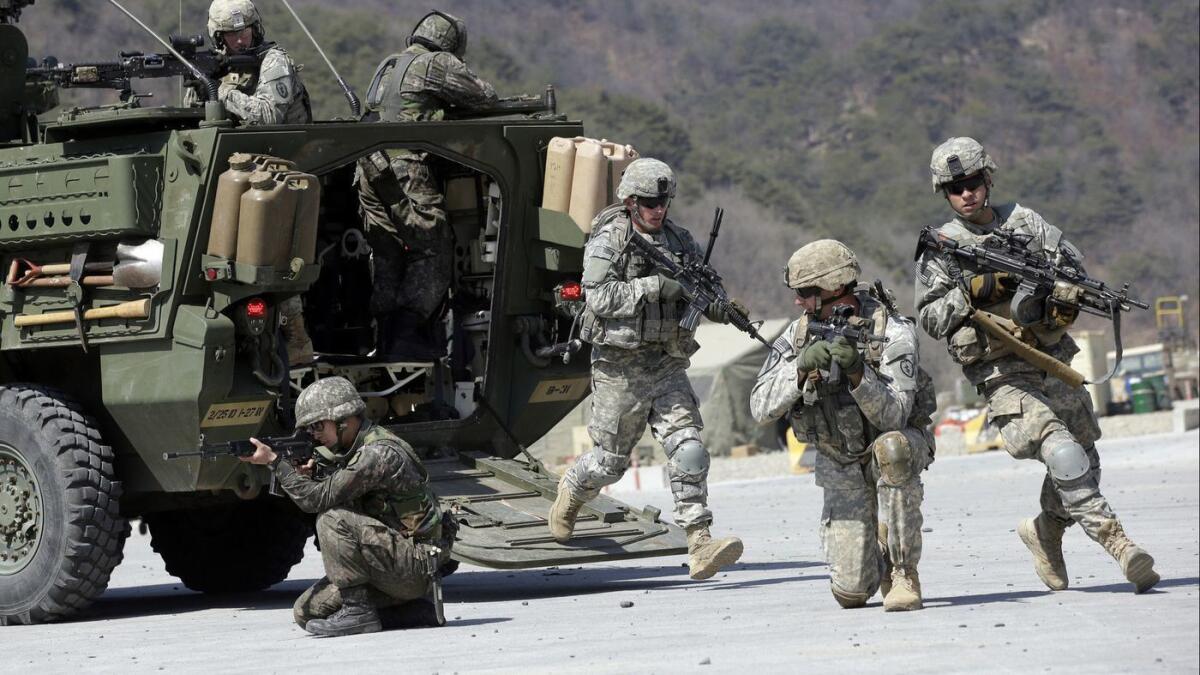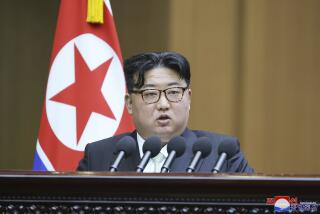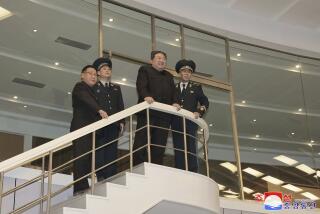Trump’s decision to halt military exercises with South Korea leaves Pentagon and allies nervous

President Trump announced a halt to joint military exercises with South Korea on Tuesday, raising alarm at the Pentagon, in Congress and among allies that the U.S. might back away from longstanding defense commitments in the region without concrete concessions from long belligerent North Korea.
Trump unveiled the move at a news conference with North Korean dictator Kim Jong Un after their summit in Singapore. He said he also wants to eventually withdraw the more than 28,000 U.S. troops permanently stationed in the South as a deterrent against North Korea, which only months ago was threatening Seoul and Washington with nuclear war.
Administration officials said halting the joint exercises is a relatively modest concession that has great symbolic importance to Pyongyang. By helping to build trust between two longtime adversaries, the officials argued, the U.S. action could make it more likely that Kim will move forward on talks aimed at eliminating his nuclear arsenal.
But Trump’s seemingly off-hand remarks, without warning to allies South Korea and Japan, marked a potentially sharp shift in U.S. defense posture in East Asia and contradicted decades of statements by American officials that the exercises are defensive only and critical for deterring North Korea.
Further unsettling foreign allies and even Republicans in Congress, the president echoed North Korea’s own pejorative phrases in announcing suspension of the joint exercises with South Korea. Trump said he had agreed to stop the “war games” because they are “very provocative,” terms used by North Korea in denouncing the drills, adding that it would save the United States “a tremendous amount of money.”
He said the exercises would be suspended “unless and until we see the future negotiation” on eliminating Pyongyang’s nuclear arsenal “is not going along like it should.”
The decision was quickly portrayed by critics as a one-sided giveaway to a country that maintains one of the largest standing military forces in the world.
“These exercises for years have served as an important signal that the United States supports our allies in the region,” Sen. Dianne Feinstein (D-Calif.) said in a statement. “It concerns me that the president is making concessions to North Korea with nothing to show in return.”
Former Vice President Joe Biden said Trump had “reduced our leverage and signaled a weakening of our alliance in return for vague promises to begin nuclear negotiations” from an adversary that repeatedly has broken promises.
Sen. David Perdue of Georgia, a Republican member of the Senate Armed Services Committee, told reporters he was “very troubled” and “surprised.”
The annual exercises, which include warplanes and naval maneuvers, have been held since at least 1976 to help the allied forces prepare for a possible North Korean attack.
In response to Republican senators’ worries, Vice President Mike Pence reassured them that smaller, routine training exercises will continue, according to Sen. Cory Gardner (R-Colo.).
Pentagon officials have long believed that the much larger, yearly exercises deter North Korea and improve the readiness of U.S. and South Korean troops. Former military commanders who worked in South Korea say the drills are essential in a foreign theater with an annual turnover of rank-and-file service members, their officers and the civilian analysts who support them.
This year, four separate exercises were conducted from early April to late May. One, called Foal Eagle, involved 11,500 U.S. and 290,000 South Korean troops. It was followed by Key Resolve, which used computer simulation of a possible attack by North Korea to improve headquarters command and control.
Those were followed by Warrior Strike and Max Thunder, the latter an Air Force exercise that originally included sending U.S. bombers from Guam to South Korean airspace. Commanders abandoned that scenario to avoid angering Pyongyang ahead of the summit.
Suspending all such drills without parallel concessions from Pyongyang could make reaching a larger deal on restricting North Korea’s nuclear arsenal even tougher, said Michael Green, senior vice president for Asia at the Center for Strategic and International Studies.
It takes away leverage from Secretary of State Mike Pompeo, who is expected to lead continuing talks with North Korea, Green said, and “is heartwarming for Moscow and Beijing.” Russia and China have long joined North Korea in denouncing the U.S. maneuvers in South Korea as a rehearsal for invasion.
The move could also impose a de facto timeline for making progress in the forthcoming nuclear talks because, with another round of military exercises scheduled for late August, Pompeo may want to see concrete actions out of Pyongyang by then, said Victor Cha, formerly a national security advisor to the George W. Bush administration.
Trump’s announcement apparently caught U.S. military commanders and officials in South Korea and Japan by surprise. Both countries have longstanding defense treaties with the United States.
“There is concern for both allies,” Cha said, “that Trump does not really value alliances and commitments. They are seeing their issues become bargaining chips” with Kim.
The U.S. military command in South Korea has “received no official updated guidance on execution or cessation on any upcoming training exercises,” said Army Col. Chad Carroll, a spokesman for the command. “We will continue with our current military posture until we receive updated guidance.”
Defense Secretary James N. Mattis, however, was “not surprised” by the decision to cancel the drills, said spokeswoman Dana White. “They had spoken on all of these issues well in advance.”
Green, the Asia scholar at CSIS, said it was “astonishing” and “unprecedented” for an American president to tell an adversary like Kim of his military plans before informing affected allies.
For Trump to show that he is “a leader willing to cut out allies” — on the heels of his break with allies at the weekend Group of 7 summit in Canada — “there will be ripple effects as far as Canberra [Australia] and maybe London,” Green said.
Officials in Japan especially fear that in Trump’s eagerness for a deal, he might bargain away key elements of U.S. security strategy in Northeast Asia, leaving Japan’s territory vulnerable to Kim’s short- and medium-range missiles.
South Korea has been more supportive of Trump’s outreach to Kim, and its president, Moon Jae-in, did not mention the decision to suspend military exercises in a statement praising the summit outcome.
But conservative South Korean politicians are likely to seize on the move as evidence that Trump may be willing to sacrifice longstanding pillars of the U.S.-South Korean alliance in his pursuit of a deal with Kim.
“The entire process can only succeed if South Korea and the U.S. stand in close coordination,” said Thomas Countryman, former assistant secretary of State for nonproliferation. Trump’s announcement “was not a positive sign but also not a fatal flaw...because it can be reversed.”
It is not the first time that the United States has halted military maneuvers with South Korea to entice Pyongyang to reach a deal.
In 1992, the George H.W. Bush administration canceled exercises involving hundreds of thousands of U.S. and South Korean troops to encourage North Korea to cooperate with nuclear inspections. The Clinton administration did so again from 1994 to 1996, but resumed maneuvers in 1997 amid growing tensions with the North.
The U.S. has stationed troops in South Korea since the Korean War. Together with major U.S. air and Navy bases in Japan, the Pentagon keeps a massive military presence in Northeast Asia to support a defense treaty that requires the United States to come to South Korea’s aid if it is attacked.
It’s unclear how much money the Pentagon would save by suspending the exercises. Trump provided no estimate.
For decades, Washington has gradually shifted the cost of keeping troops there onto the government in Seoul. South Korea now pays more than $890 million a year, about half the annual cost for the deployment, not including personnel expenses that the Defense Department would incur no matter where the troops were located.
Trump has insisted repeatedly, and inaccurately, that Japan and other U.S. allies contribute little or nothing to the United States for their own defense. He rarely acknowledges that the United States has long considered its presence in Northeast Asia to be in its own national interest, not least as a regional bulwark against China.
Abraham Denmark, a Pentagon official responsible for Asia during the Obama administration, said in a tweet that Kim had emerged from the summit meeting in Singapore with a “huge propaganda win and a metric ton of legitimacy.” The United States, he added, “gave up joint exercises, for little new and nothing in return.”
Times staff writer Tracy Wilkinson contributed to this report.
Twitter: @davidcloudLAT
UPDATES:
1:10 p.m.: This article was updated with a statement from former Vice President Biden.
This article was originally published at 12:55 p.m.
More to Read
Start your day right
Sign up for Essential California for news, features and recommendations from the L.A. Times and beyond in your inbox six days a week.
You may occasionally receive promotional content from the Los Angeles Times.







